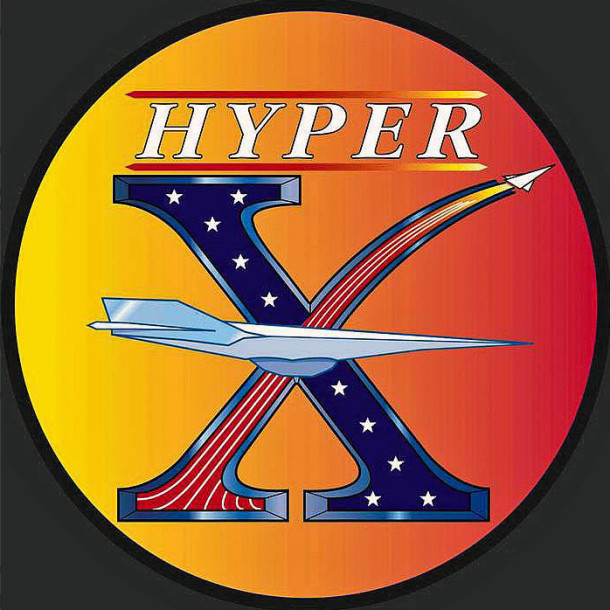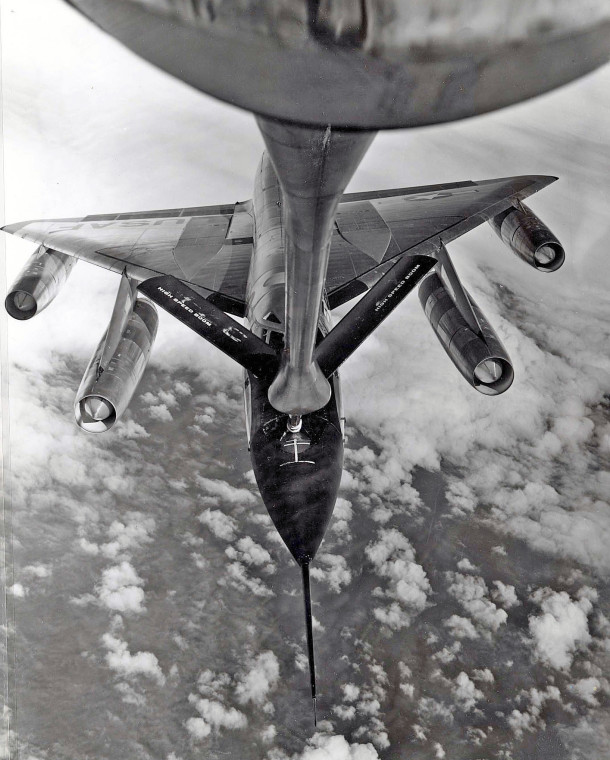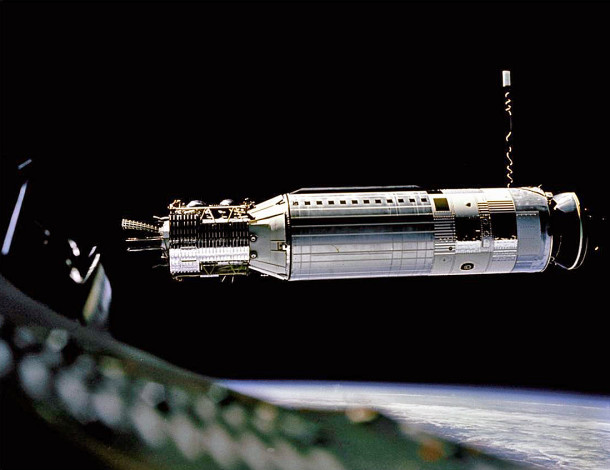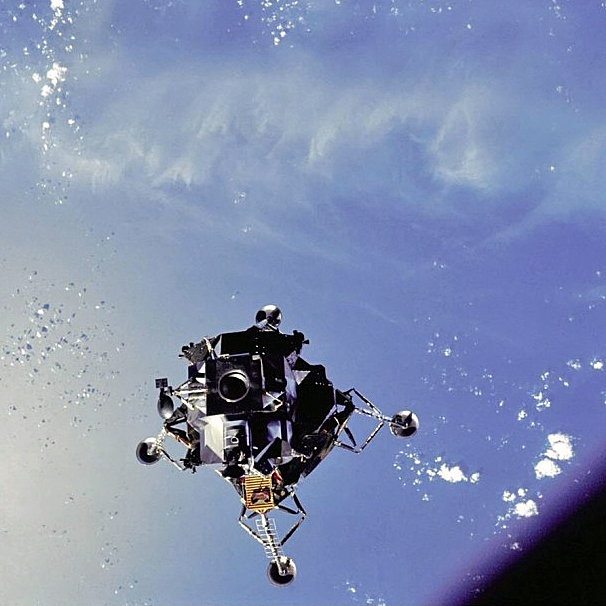
Fourteen years ago today, the NASA X-43A scramjet-powered flight research vehicle reached a record speed of over 4,600 mph (Mach 6.83). The test marked the first time in the annals of aviation that a flight-scale scramjet accelerated an aircraft in the hypersonic Mach number regime.
NASA initiated a technology demonstration program known as HYPER-X in 1996. The fundamental goal of the HYPER-X Program was to successfully demonstrate sustained supersonic combustion and thrust production of a flight-scale scramjet propulsion system at speeds up to Mach 10. The term scramjet stands for Supersonic Combustion RAMJET.
The scramjet is a key to sustained hypersonic flight within the earth’s atmosphere. Whereas rockets are capable of producing large thrust magnitudes, both the duration of operation and the amount of thrust per unit propellant mass is low. In part, this is because a rocket has to carry its own fuel and oxidizer supplies. A scramjet is a much more efficient producer of thrust in that it only has to carry its fuel and uses the atmosphere as its oxidizer source.
Rocket technology is a highly developed discipline with a deep experience and application base. In contradistinction, flight-scale scramjet technology is still in a developmental stage. Considerations such as initiating and sustaining stable combustion is a supersonic stream, efficient conversion of fuel chemical energy to kinetic energy, and optimal integration of the scramjet propulsion system into a hypersonic airframe are among the challenges that face designers.
Also known as the HYPER-X Research Vehicle (HXRV), the X-43A aircraft was a scramjet test bed. The aircraft measured 12 feet in length, 5 feet in width, and weighed nearly 3,000 pounds. The X-43A was boosted to scramjet take-over speeds with a modified Orbital Sciences Pegasus rocket booster.
The combined HXRV-Pegasus stack was referred to as the HYPER-X Launch Vehicle (HXLV). Measuring approximately 50 feet in length, the HXLV weighed slightly more than 41,000 pounds. The HXLV was air-launched from a B-52 mothership. Together, the entire assemblage constituted a 3-stage vehicle.
The second flight of the HYPER-X program took place on Saturday, 27 March 2004. The flight originated from Edwards Air Force Base, California. Using Runway 04, NASA’s venerable B-52B (S/N 52-0008) started its take-off roll at approximately 20:40 UTC. The aircraft then headed for the Pacific Ocean launch point located just west of San Nicholas Island.
At 21:59:58 UTC, the HXLV fell away from the B-52B mothership. Following a 5 second free fall, rocket motor ignition occurred and the HXLV initiated a pull-up to start its climb and acceleration to the test window. It took the HXLV about 90 seconds to reach a speed of slightly over Mach 7.
Following rocket motor burnout and a brief coast period, the HXRV (X-43A) successfully separated from the Pegasus booster at 94,069feet and Mach 6.95. The HXRV scramjet was operative by Mach 6.83. Supersonic combustion and thrust production were successfully achieved. Total power-on flight duration was approximately 11 seconds.
As the X-43A decelerated along its post-burn descent flight path, the aircraft performed a series of data gathering flight maneuvers. A vast quantity of high-quality aerodynamic and flight control system data were acquired for Mach numbers ranging from hypersonic to transonic. Finally, the X-43A impacted the Pacific Ocean at a point about 450 nautical miles due west of its launch location. Total flight time was approximately 15 minutes.
The HYPER-X Program made history that day in late March 2004. Supersonic combustion and thrust production of an airframe-integrated scramjet were achieved for the first time in flight; a goal that dated back to before the X-15 Program. Along the way, the X-43A established a speed record for airbreathing aircraft and earned a Guinness World Record for its efforts.

Fifty-six years ago this month, a USAF/Convair B-58A Hustler from the 43rd Bomb Wing at Carswell AFB, Texas set a trio of transcontinental speed records in a round trip from Los Angeles to New York and back. This historic feat was accomplished as part of Operation Heat Rise.
The USAF/Convair B-58A Hustler holds the distinction of being the world’s first supersonic bomber. A product of the 1950’s, the delta-winged aircraft measured 96.8 feet in length and had a wing span of 56.8 feet. GTOW stood around 163,000 lbs. Power was provided by a quartet of General Electric 79 turbojets which produced 62,000 lbs of sea level thrust in afterburner.
The Hustler’s performance was impressive then and now. With a maximum speed of 1,325 mph, the aircraft featured a service ceiling of 64,800 feet and a combat radius of 1,520 nautical miles. The Hustler’s mission range could be markedly increased through employment of aerial refueling.
The B-58’s three man air crew sat in tandem in the order of pilot, navigator and Defensive Systems Officer (DSO). Each man occupied a separate flight station which was equipped with an ejection pod for protection during high speed egress.
The Hustler was part of Strategic Air Command (SAC). It’s primary mission was delivery of nuclear weapons. The aircraft served in the air force’s operational inventory for a period of just 10 years years (1960 to 1970). A total of 116 airframes were produced and none were used in anger.
The Hustler’s high speed capability led to the type being used to establish numerous speed records during its operational life. Operation Heat Rise was one such effort. The goal of this project was to establish segmental and overall speed records for a round trip flight between the west and east coasts of the United States.
On Monday , 05 March 1962, the crew of Major Robert G. Sowers (pilot), Captain Robert MacDonald (navigator) and Captain John T. Walton (DSO) departed Carswell AFB, Texas in B-58A S/N 59-2458 known as the Cowtown Hustler. Other than a new wax job, this aircraft was no different than the other Hustler airframes in the USAF supersonic bomber inventory.
After refueling out over the Pacific Ocean, the aircraft started its coast-to-coast speed run at Mach 2 over Los Angeles, California. Incredibly, the critical ground station monitoring the start time did not record passage of the aircraft overhead. Thus, airplane and crew were called back for a restart of the speed record attempt! This meant another trip to the tanker out over the Pacific to top off the Hustler’s fuel tanks prior to the second try.
Once officially underway, the trip from overhead Los Angeles to overhead New York took 2 hours and 58.71 seconds for an average speed of 1,214.65 mph. The aircraft was refueled over Kansas on its way east. Once out over the Atlantic Ocean, the Hustler reversed course and hit the tanker again.
The return trip from overhead New York to overhead Los Angeles was flown in 2 hours, 15 minutes and 50.08 seconds. As on the eastbound leg, the Hustler took on a load of gas over Kansas. The entire round trip required 4 hours, 41 minutes and 14.98 seconds inclusive of refueling. Each of the aforementioned trip times established new performance records.
An interesting aspect of the return leg to Los Angeles was that the Hustler flew faster than the rotational movement of the earth. Thus, the aircraft and its crew arrived in California roughly 41 minutes earlier than the sun!
After landing in Los Angeles, the crew was enthusiastically greeted by members of the air force, the aerospace industry and the media. In recognition of their accomplishments, each man received the USAF Distinguished Flying Cross at the hand of USAF General Thomas S. Power, Chief of Staff.
Finally, for their impressive performance during Operation Heat Rise, crew and aircraft were the recipients of both the 1962 MacKay and Bendix Trophies. This marked the last time that the latter was ever awarded.

Fifty-two years ago this week, the crew of Gemini VIII successfully regained control of their tumbling spacecraft following failure of an attitude control system thruster. The incident marked the first life-threatening on-orbit emergency and resulting mission abort in the history of American manned spaceflight.
Gemini VIII was the sixth manned mission of the Gemini Program. The primary mission objective was to rendezvous and dock with an orbiting Agena Target Vehicle (ATV). Successful accomplishment of this objective was seen as a vital step in the Nation’s quest for landing men on the Moon.
The Gemini VIII crew consisted of Command Pilot Neil A. Armstrong and Pilot USAF Major David R. Scott. Both were space rookies. To them would go both the honor of achieving the first successful docking in orbit as well as the challenge of dealing with the first life and death space emergency involving an American spacecraft.
Gemini VIII lifted-off from Cape Canaveral’s LC-19 at 16:41:02 UTC on Wednesday, 16 March 1966. The crew’s job was to chase, rendezvous and then physically dock with an Agena that had been launched 101 minutes earlier. The Agena successfully achieved orbit and waited for Gemini VIII in a 161-nm circular Earth orbit.
It took just under six (6) hours for Armstrong and Scott to catch-up and rendezvous with the Agena. The crew then kept station with the target vehicle for a period of about 36 minutes. Having assured themselves that all was well with the Agena, the world’s first successful docking was achieved at a Gemini mission elapsed time of 6 hours and 33 minutes.
Once the reality of the historic docking sank in, a delayed cheer erupted from the NASA and contractor team at Mission Control in Houston, Texas. Despite the complex orbital mechanics and delicate timing involved, Armstrong and Scott had actually made it look easy. Unfortunately, things were about to change with an alarming suddenness.
As the Gemini crew maneuvered the Gemini-Agena stack, their instruments indicated that they were in an uncommanded 30-degree roll. Using the Gemini’s Orbital Attitude and Maneuvering System (OAMS), Armstrong was able to arrest the rolling motion. However, once he let off the restoring thruster action, the combined vehicle began rolling again.
The crew’s next action was to turn off the Agena’s systems. The errant motion subsided. Several minutes elapsed with the control problem seemingly solved. Suddenly, the uncommanded motion of the still-docked pair started again. The crew noticed that the Gemini’s OAMS was down to 30% fuel. Could the problem be with the Gemini spacecraft and not the Agena?
The crew jettisoned the Agena. That didn’t help matters. The Gemini was now tumbling end over end at almost one revolution per second. The violent motion made it difficult for the astronauts to focus on the instrument panel. Worse yet, they were in danger of losing consciousness.
Left with no other alternative, Armstrong shut down his OAMS and activated the Reentry Control System reaction control system (RCS) in a desperate attempt to stop the dizzying tumble. The motion began to subside. Finally, Armstrong was able to bring the spacecraft under control.
That was the good news. The bad news for the crew of Gemini VIII was that the rest of the mission would now have to be aborted. Mission rules dictated that such would be the case if the RCS was activated on-orbit. There had to be enough fuel left for reentry and Gemini VIII had just enough to get back home safely.
Gemini VIII splashed-down in the Pacific Ocean 4,320 nm east of Okinawa. Mission elapsed time was 10 hours, 41 minutes and 26 seconds. Spacecraft and crew were safely recovered by the USS Leonard F. Mason.
In the aftermath of Gemini VIII, it was discovered that OAMS Thruster No. 8 had failed in the ON position. The probable cause was an electrical short. In addition, the design of the OAMS was such that even when a thruster was switched off, power could still flow to it. That design oversight was ultimately remediated so that subsequent Gemini missions would not be threatened by a reoccurence of the Gemini VIII anomaly.
Neil Armstrong and David Scott met their Goliath in orbit and defeated the beast. Armstrong received a quality increase for his exceptional efforts on Gemini VIII while Scott was promoted to Lieutenant Colonel. Both men were also awarded the NASA Exceptional Service Medal.
More significantly, their deft handling of the Gemini VIII emergency elevated both Armstrong and Scott within the ranks of the astronaut corps. Indeed, each man would ultimately land on the Moon and serve as mission commander in doing so; Neil Armstrong on Apollo 11 and David Scott on Apollo 15.

Forty-nine years ago this month, the Apollo Lunar Module (LM) was flown by an astronaut crew in space for the first time during the Apollo 9 earth-orbital mission. This technological achievement was critical to the success of the first lunar landing mission which occurred a little over 4 months later.
The Apollo Lunar Module (LM) was the world’s first true spacecraft in that it was designed to operate in vacuum conditions only. It was the third and final element of the Apollo spacecraft; the first two elements being the Command Module (CM) and the Service Module (LM).
The LM had its own propulsion, life-support and GNC systems. The vehicle weighed about 32,000 lbs on Earth and was used to transport a pair of astronauts from lunar orbit to the lunar surface and back into lunar orbit.
The spacecraft was really a two-stage vehicle; a descent stage and an ascent stage weighing 22,000 lbs and 10,000 lbs on Earth, respectively. The thrust of descent stage rocket motor could be throttled and produced a maximum thrust of 10,000 lbs while the ascent stage rocket motor was rated at 3,500 lbs of thrust.
On Monday, 03 March 1969, Apollo 9 was rocketed into earth-orbit by the mighty Saturn V launch vehicle. The primary purpose of this mission was to put the first LM through its paces by astronauts preparatory to the first lunar landing attempt.
During the 10-day mission, the crew of Commander James A. McDivitt, CM Pilot David R. Scott and LM Pilot Russell L. “Rusty” Schweickart fully verified all moon landing-specific operational aspects (short of an actual landing) of the LM. Key orbital activities included multiple-firings of both LM rocket motors and several rendezvous and docking exercises in which the LM flew as far away as 113 miles from the CM/SM pair.
By the time the crew splashed-down in the Atlantic Ocean on Thursday, 13 March 1969, America had a new operational spacecraft and a fighting chance to land men on the moon and safely return them to the Earth before the end of the decade.





